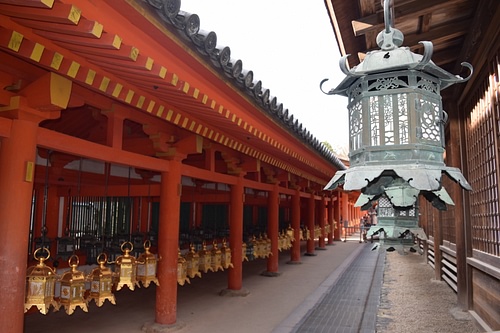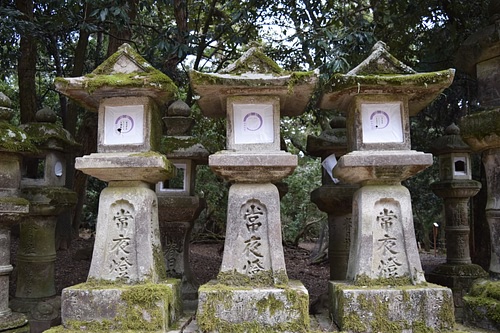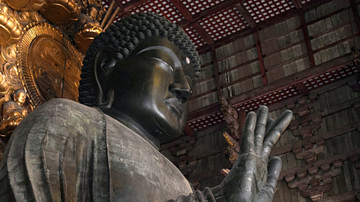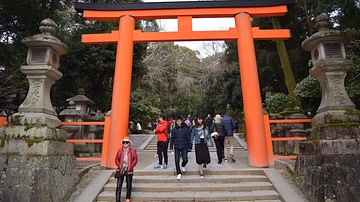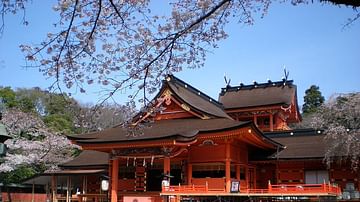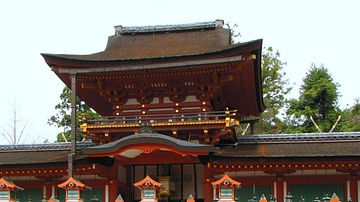
Kasuga Taisha is an ancient Shinto shrine located in a forest east of Nara, capital of Japan between 710 and 784 CE. Founded in 768 CE, the site has four main shrines in honour of four Shinto-Buddhist deities, one of which is the ancestor god of the important Fujiwara clan. The complex, including its surrounding forest with wild deer, is listed as a UNESCO World Heritage Site.
Enshrined Gods
The shrine was officially founded in 768 CE, although historians prefer a date of 710 CE. It was established by the powerful Fujiwara clan after, as the legend goes, a deity appeared at the site riding a deer, which also explains why deer are left to roam freely at the temple even today. The site still includes a shrine dedicated to the founding ancestor of the Fujiwara. The shrines are surrounded by a cypress forest in which both hunting and the cutting down of trees have been banned since 841 CE. In the same forest are the Kofukuji and Todaiji Buddhist temples.
The four main kami or Shinto spirits of Kasuga Taisha are Ame no Koyane no mikoto, the founding Fujiwara ancestor, Himegami, Takemikazuchi no mikoto (the deer-riding deity and thunder god), and Futsunushi no mikoto (a warrior god and great swordsman). The latter two were believed to have been sent by the gods when Ninigi came to rule on earth, Japan's first ruler according to Shinto mythology. Kasuga Taisha appeals to the Buddhist faithful because Takemikazuchi is considered the avatar of Fukukensaku Kannon. Similarly, Ame no Koyane is equated with Jizo, Himegami with Juichimen Kannon, and Futsunushi with Yakushi Nyorai. Another link with Buddhism is the site's famous deer as this reminds of the deer park where the Buddha is thought to have given his first sermon.
Kasuga Architecture
During the Heian period (794-1185 CE) the temple came under the auspices of the Kofuku-ji temple, the Fujiwara clan temple at Nara. The complex was influential in its own right, though, right up to the 19th century CE and grew to include over 175 buildings. There are few original ancient buildings at the site because, as with many other Shinto shrines, structures are regularly rebuilt in the process known as shikinen sengu in order to keep them pristine and free from spiritual impurity. The oldest honden (main hall) shrine today dates to 1863 CE.
The four main shrines of the complex gave their name to the kasuga-zukuri architectural style, which is seen at smaller shrines elsewhere. The style is typified by a honden with a simple rectangular structure and a curved gabled roof decorated with chigi (V-shaped projections) at each roof end and katsuogi (cylinders laid across the roof ridge). The entrance is via steps covered by a simple roof canopy. Wooden parts are painted red and black, while the walls are plastered white and the roofs are made from cypress bark. The four shrines are set in a row and each measures around 2.6 x 1.8 metres (8.5 x 6 ft). The Wakamiya Jinja, founded in 1135 CE, is a secondary shrine and is also in the kasuga-zukuri style.
One of the most impressive structures is the Chumon Gate. Built in 1613 CE, it has a sweeping two-storey central roof and two wings which house secondary shrines. Next to the gate is a cedar tree thought to be over 800 years old and the subject of a picture scroll which dates to 1309 CE. The same tree appears on the stage scenery of every No stage play, too, because that form of theatre was first performed at Kasuga in the 14th century CE.
The shrine's main entrance is the more modest Nanomon or South Gate. Two more gates break the shrine's surrounding kairo wall, built in 1613 CE. Other buildings include the heiden (prayer and offering hall) and the red hoko or storehouse. Finally, there is the Treasure Hall and Meoto Daikokusha, both of which contain precious sculptures, weapons, masks, and mirrors, many of which were imperial gifts given during the Heian Period.
Kasuga's Lanterns
The site is particular for its 2,000-plus stone lanterns (ishidoro), which line the pathway to the shrines. These lanterns, a traditional way to greet the spirits of the dead, have been donated by worshippers over the centuries. Many of the lanterns are decorated with an image of a deer and are particularly ornate, giving rise to a type of lantern which carries the Kasuga name. Another 1,000 bronze lanterns hang around the shrines and gates at the site. All the lanterns at Kasuga are lit in the spectacular Setsubon and Obon Mantoro ceremonies held each February and August respectively. The site is also particularly picturesque in late spring when its many wisteria bloom in the botanical gardens and the shrine earns its name of kasuga or 'field of wisteria'.
This content was made possible with generous support from the Great Britain Sasakawa Foundation.
